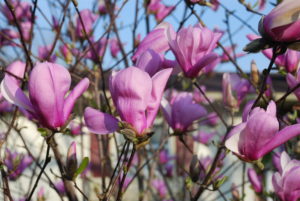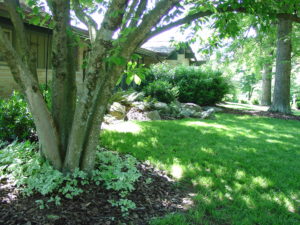Saucer magnolias (M. x soulangeana) are deciduous hybrid magnolias (M. denudata x M. liliiflora) as broad shrubs or small trees. They typically grow 20-30 feet in height and width. Saucer magnolias are often called tulip magnolias because of the shape of the colorful blooms. Flower colors range from white, pink, rose, purple, magenta, and burgundy. Flowers are pink with white interiors.
There are hundreds of hybrid cultivars available in nursery commerce. Be aware that the early blooms are prone to spring frost injury. Saucer magnolias do not tolerate heavy wind or salt spray.
Large fragrant flowers (to 10 inches across) open before the leaves emerge. Sparse numbers of additional flowers may bloom sporadically later in spring on new growth, but the later flowers are usually less vigorous and less colorful than those of the primary bloom.
Saucer magnolias date back to the 1820’s and are widely planted across the U.S. and Europe. In the early spring garden, saucer magnolia is a landscape show-stopper. Lush summertime leaves are dark green and leathery—adding nice contrast to silvery-gray bark. The husky gray branches and big, fuzzy flower buds stand out in the winter landscape.
Saucer magnolias thrive in a moist, humus-rich, mildly acidic, well-drained soil and in full to partial sunlight. For optimum flowering, mature trees should have more sunlight. The tree’s shallow competitive roots are best maintained in a grass-free mulched area. Trees tolerate short periods in wet soggy soils without injury. Once established, generally after 1-2 year span, saucer magnolias are highly tolerant of summer dry spells. Summer leaves may turn yellow (chlorotic) in iron deficient alkaline soils. Disease and pest problems are rare.
Balled-and-burlapped (b&b) or container-grown plants are best planted from late winter up to the early days of autumn. Prevent soil compaction around root zone by limiting foot traffic over the root system. Magnolias seldom have serious pest or disease problems; inspect for magnolia scale. Deer generally stay away from magnolias.



 Posted in
Posted in 
